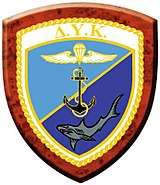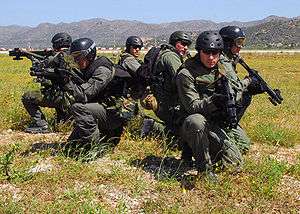Underwater Demolition Command
The Underwater Demolition Command (Greek: Διοίκηση Υποβρυχίων Καταστροφών), abbreviated as DYK (Greek: ΔΥΚ,Greek pronunciation: [ðik]) and known until 2001 as the Underwater Demolition Unit (Greek: Μονάδα Υποβρυχίων Καταστροφών), abbreviated as MYK (Greek: ΜΥΚ, Greek pronunciation: [mik]), is the Greek Navy's elite special warfare unit.
| Underwater Demolition Command | |
|---|---|
| Διοίκηση Υποβρυχίων Καταστροφών (ΔΥΚ) | |
 Underwater Demolition Command (DYK) emblem | |
| Active | 1957–Present |
| Country | |
| Branch | |
| Type | Special Forces |
| Role |
|
| Size | Classified |
| Part of | Naval Training Command (Greek: Διοίκηση Ναυτικής Εκπαίδευσης (ΔΝΕ)) |
| Nickname(s) | |
| Engagements | Gulf War Albanian Civil War |
| Website | Underwater Demolition Command |
| Commanders | |
| First | Captain Panagiotis Nikolareas |
| Insignia | |
| Abbreviation | Δ.Υ.Κ. |
History
Carrying on the tradition of the Hellenic Navy in naval special operations, the unit was established in 1957 with help from the United States Navy's Underwater Demolition Team, when two Greek officers were sent to Little Creek in Virginia to evaluate a UDT operational capability for the Hellenic Navy. On their return, they trained a dozen men who formed the nucleus of the MYK cadre.
Several diver teams (OYK) of MYK have been deployed on numerous occasions. They were deployed during the first Gulf War in 1991, providing assistance for the naval embargo against Saddam Hussein, boarding 217 suspect vessels. In 1996, the OYK were involved in the Imia crisis when Turkish commandos infiltrated the Greek rocky island of Imia. Small OYK teams dispersed in on a neighboring islet to acquire Turkish targets with the order to eliminate them if the pending political solution to the crisis and withdrawal of Turkish forces would fail.
In 1997, during the violent unrest that erupted in neighboring Albania, the OYK were responsible for taking control of the international airport of Tirana and the evacuation of 240 foreign dignitaries from Albania (Operation Kosmas).[1]
Structure
The DYK is organized into sections called Underwater Demolition Teams (Greek: Ομάδες Υποβρυχίων Καταστροφών), commonly known in their abbreviated form as OYK (Greek: ΟΥΚ,Greek pronunciation: [oik]), that specialize in a particular area. Each section consists of 25 men split into five teams of five or alternatively into two subsections of twelve. Each OYK diver is awarded with the occupational specialty of Underwater Demolitionist (Greek: Υποβρύχειος Καταστροφέας) abbreviated Y/KT upon the successful completion of his training.
OYK-1 and OYK-2 are the main assault sections of the OYK that conduct unconventional warfare, sabotage, DA raids, naval boarding and maritime counter-terrorism..
OYK-3: This section specializes in reconnaissance and hydrographic survey. Establishing and reconnoitering beach landing sites prior to a main amphibious assault, battlefield preparation and providing shore intelligence in the area of interest.
OYK-4: are responsible for planting explosive charges on enemy shipping, EOD and naval mine clearance by organic means or in conjunction with a minesweeper vessel, as well as underwater demolition of obstacles that may prevent an amphibious landing.
OYK-5 is a reserve section that is only activated in wartime or a declared state of emergency. It is made up of reservist personnel from the DYK and Officers and Petty Officers from the instructor body. ΟΥΚ-5 is a deceptively small unit since it is manned by the all the previous OYK specialty schools, the Underwater Demolition school, the Unconventional War Boat school, the Underwater Swimmer Delivery school, and the Underwater Demolition Base (Greek: ΟΑΠ, ΟΑΕ, ΟΕΝ, ΣΥΚ, ΣΑΠ, ΥΠΟΧ & ΒΥΚ) respectively, effectively the rest of the DYK.
OYK training

The selection and training course lasts roughly seven months and is divided into three phases similar to that of the US Navy SEALs BUD/S course. The course has an extremely high failure rate similar to that of its US counterparts. The candidates will go on to airborne school and then continue to learn advanced naval special warfare techniques.
OYK equipment
The OYK is known to use various types of firearms to complete their missions with some guns being customized to be able to adapt to the marine environment of the OYK.[2]
- Glock 17 9x19mm (does have sub-aqua spring cups to help with the marine environment to allow the gun to shoot right when it pulled out in the water and has an extended threaded barrel that can attach a suppressor if needed)
- Glock 18 9x19mm (has been utilized in the past, thought the standard issue is the Glock 17)
- Heckler & Koch MP5SD 9x19mm (MP5 variant used is the MP5A3)
- M4 Carbine 5.56x45mm (is usually equipped with a Holographic sight and a fore-grip)
- M4A1 5.56×45mm (is equipped with Acog holographic and sometimes with a magnifier ×1, as well as fore-grips)
- FN Minimi 7.62x51mm
- M60E4 7.62x51mm
- Springfield Armory M21 Sniper Weapon System 7.62x51mm
- Benelli M3T 12 Gauge
- Barrett M82A1 .50 BMG
- Accuracy International AWM
- M110 Semi-Automatic Sniper System
- M203 Grenade Launcher
2015 Independence Day Parade Controversy
The OYK generated controversy at the Greek Independence Day parade of 2015, when it chanted a nationalistic refrain: «Και το όνειρο μας είναι / στην Πόλη εμείς να μπούμε / σημαία να υψώσουμε / τον ύμνο εμείς να πούμε», roughly translated as 'Our dream is to enter the City (Constantinople) to raise our flag and sing our anthem'. Opposition ministers from the PASOK party launched attacks on the defence Minister Panos Kammenos, accusing him of mishandling matters of vital foreign policy. Concerns were also expressed by the government (SYRIZA) MP Vassiliki Katrouvanou, who called the chants 'a clear offense to our republic', and highlighted the ongoing need to remove certain far-right elements from the Greek armed forces.[3]
See also
- Zeta Amphibious Raider Squadron (Z' MAK), the Hellenic Army elite amphibious reconnaissance and amphibious strike unit attached to the 13th Special Operations Command in the 1st Raider/Paratrooper Brigade (Greece).
.svg.png)